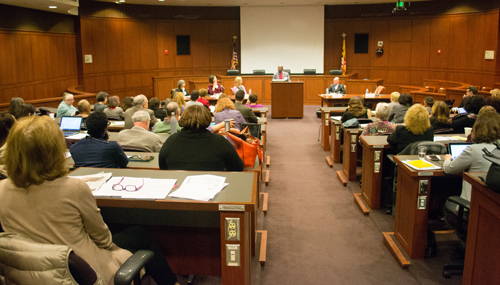What makes a family, what rules and agreements underpin them, and the ways family members can work through conflicts are all changing. On Nov. 13, a daylong conference at the University of Maryland Francis King Carey School of Law co-sponsored by the University of Baltimore (UB) Family Law Association, the Maryland Law Review, and the Maryland State Bar Association Alternative Dispute Resolution Section examined many aspects of this evolving area of law and the ways the traditional, court-based approach to family justice sometimes fails the most vulnerable family members it is meant to protect.
With seminars examining alternative dispute resolution (ADR) in child custody and access, adoption, post-adoption contracts, and the use of restorative justice to resolve intimate partner violence, the conference engaged the expertise of Maryland family law leaders and attracted dozens of legal and social service professionals from across the state.
"Most of the clients that come into our office think they have to go to court," said Suzy Eckstein, JD, of Oakley and Eckstein. "But 99 percent of them don’t have to go to court and would be better off with an alternative system where they’d get better support."
Leadoff panel moderator and UB professor Jane C. Murphy, JD, argued most family disputants are unequipped to navigate a family justice system designed by and for lawyers. Murphy brought to the panel many of the themes presented in Divorced From Reality: Rethinking Family Dispute Resolution, the book she co-authored with Carey Law professor Jana Singer, JD. The book argues a need exists to move family law away from the adversarial system toward a model that focuses on resolving legal and non-legal issues – especially as more children are born and raised outside of marriage, fathers seek more active roles in children’s lives, and the opportunities for disputes grow.

University of La Verne College of Law Dean Gilbert Holmes addresses the Innovations in Family Dispute Resolution conference at UM Carey Law.
Fellow leadoff panelist Gilbert Holmes, JD, dean of the University of La Verne College of Law, agreed, arguing changes in approach to family law can have an even greater transformative impact. "Family law can lead the way for total legal reform," he said. "If we can make it work with children, we certainly can make it work with corporations, we can make it work with the criminal justice system."
Later panels explored rapidly evolving areas of family law, such as adoption and post-adoption contact agreements, or PACAs. In her book Love’s Promises: How Formal & Informal Promises Shape All Kinds of Families, Carey Law professor Martha Ertman, JD, uses her own adoption journey to delve deeply into the many forms of agreements that create the environment of family relationships. These include not only legal contracts, but also what she calls “deals,” often emotionally charged understandings that may be unenforceable in court, but shape a family’s landscape.
Ertman’s panel also discussed one of the most noticeable trends in adoption agreements – the change in post-adoption relationships. “Ninety-five percent of adoptions in this country involve some degree of openness,” said Varda Makovsky, LCSW-C, of the Barker Adoption Foundation. “There must be some buy-in to open adoption by adoptive parents.”
One reason that buy-in is critical, Makovsky stated, is the complexity of laws governing PACAs. Maryland, like about half of the states, considers PACAs enforceable contracts. Some enforce them, so long as they serve the interests of the child. Other states either prohibit PACAs or don’t enforce them. PACAs may allow for visitation by the birth parent and often provide for regular letters and pictures, and a path for children to maintain links with birth parents.
“Historically, privacy in adoption agreements wasn’t designed to protect birth mothers,” said Elizabeth Samuels, JD, professor of law at UB. “It was designed to protect adoptive parents from interference from birth mothers.” Nowadays, many birth parents will proceed with an adoption only if a PACA is included.
“We often do mediation to set the parameters for the PACA,” Samuels added. “If they have to work through the kind of ‘mushy stuff’ that Professor Ertman talks about, it will help to sort out whether the parties are well suited.”
Conference-goers seemed most surprised by an afternoon panel that included the findings of a Maryland study assessing the effectiveness of different mediation strategies. Lead researcher Lorig Charkoudian, PhD, executive director of Community Mediation Maryland, first explained that mediation is required in Maryland family law when no domestic violence is present. As the use of mediation grows, so too does the need to define it and determine its most effective elements.
In the study, Charkoudian and her co-authors identified words and behaviors correlating with various mediation strategies, such as caucusing, reflecting, directing and eliciting. The outcomes of those strategies were then evaluated, with some unexpected findings. For example, whereas privately caucusing with each disputant tended to increase the satisfaction of both parties with the mediation process, it also was found to increase a sense of hopelessness in both and was less likely to lead to agreements. Directive strategies, on the other hand, were more likely to lead to faster (and therefore less costly) agreements, but were also more likely to later result in costly adversarial filings.
“Change in the ADR landscape is not going to come easy,” said panelist Wendy Sawyer, JD, director of the Office of Family Mediation of the Circuit Court of Baltimore County. “But there are some really simple things that can be done that we know can be helpful.”


